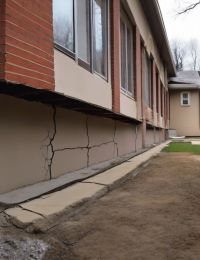Commercial buildings are essential assets for business owners, housing various operations, employees, and valuable assets. Ensuring the structural integrity of these buildings is paramount for the safety of occupants and the longevity of your investment. In this blog, we’ll explore the two common types of cracks that can affect commercial buildings: foundation cracks and hairline cracks. We’ll delve into their causes, potential risks, and recommended solutions.
Foundation Cracks: Causes and Concerns
Foundation cracks are a serious concern for any commercial building. They can take various forms, such as vertical, horizontal, diagonal, or zigzag patterns. These cracks often indicate underlying structural issues, and their severity can range from minor cosmetic concerns to significant threats to the building’s stability.
Common causes of foundation cracks in commercial buildings include:
- Soil Settlement: Uneven settlement of the underlying soil can exert uneven pressure on the foundation, leading to cracks.
- Poor Construction Practices: Inadequate foundation construction or poor-quality materials can contribute to cracks over time.
- Moisture Issues: Excessive moisture, poor drainage, or water infiltration can erode the foundation and cause cracks.
- Freeze-Thaw Cycles: In regions with cold winters, freezing and thawing can exert pressure on the foundation, leading to cracks.
- Seismic Activity: Earthquakes or ground movements in seismic zones can cause significant foundation damage.
The risks associated with foundation cracks include:
- Uneven settling, which can result in structural damage and compromised building integrity.
- Water infiltration, leading to mold growth, corrosion of reinforcement, and further deterioration.
- Safety hazards for occupants and potential legal liabilities for building owners.
Hairline Cracks: Causes and Considerations
Hairline cracks are thin, superficial cracks typically less than 1/16 inch wide. While they are often considered cosmetic, they can still raise concerns in commercial buildings.
Common causes of hairline cracks in commercial buildings include:
- Concrete Shrinkage: During the curing process, concrete can shrink slightly, leading to hairline cracks.
- Temperature Fluctuations: Rapid temperature changes can cause concrete to expand and contract, resulting in surface cracks.
- Minor Settling: Even well-constructed buildings can experience minor settling, causing hairline cracks.
While hairline cracks are generally not structurally significant, they can:
- Allow moisture infiltration, contributing to mold growth or corrosion issues.
- Impact the building’s aesthetics and potentially lower property value.
Recommended Solutions and Maintenance
When dealing with foundation cracks and hairline cracks in commercial buildings, consider the following steps:
- Inspection: Engage a professional structural engineer or building inspector to assess the cracks’ cause and severity.
- Documentation: Document the cracks with photographs and notes on size, location, and patterns.
- Repair or Remediation: Depending on expert recommendations, undertake appropriate repairs. This may involve sealing hairline cracks or more extensive foundation reinforcement for larger cracks.
- Preventative Measures: Address root causes, such as moisture management and improved drainage, to prevent future issues.
- Regular Maintenance: Implement a maintenance schedule to monitor the building’s foundation and structural elements regularly.



